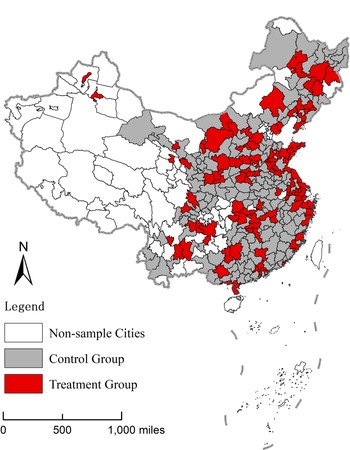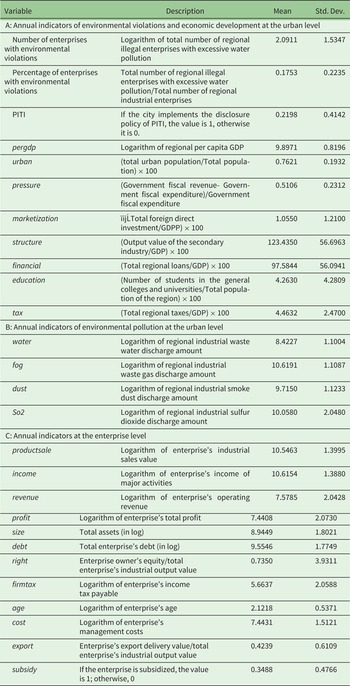1. Introduction
With rapid economic growth, a series of environmental problems – such as the excessive use of resources, aggravation of industrial emissions, and degradation of the ecological environment – appear. Serious environmental pollution not only leads to a loss of economic efficiency (Siegel, Reference Siegel1979; Christainsen and Haveman, Reference Christainsen and Haveman1981; Löfgren et al., Reference Löfgren, Wråke, Hagberg and Roth2013), but also affects human health and significantly increases mortality (Currie et al., Reference Currie, Davis, Greenstone and Walker2015; Ebenstein et al., Reference Ebenstein, Fan, Greenstone, He, Yin and Zhou2015; Clay et al., Reference Clay, Lewis and Severnini2018), thus endangering the long-term development of mankind. China's economic growth has been steadily increasing but, at the same time, the nexus between economic development and environmental pollution has become increasingly acute and intensified (Vennemo et al., Reference Vennemo, Aunan, Lindhjem and Seip2009). According to the 2021 World Air Quality Report (IQ Air, 2021), China accounted for 12 of the 100 most polluted cities in the world in 2021. He et al. (Reference He, Fan and Zhou2016) investigated the relationship between environmental pollution and mortality in the policy context of the 2008 Beijing Olympic Games, finding that environmental pollution significantly increases mortality. Moreover, according to the estimation of China's urban population in 2010, they also found every 10 μg/m3 decrease in the PM10 concentration will lead to 285,190 fewer deaths among urban residents, with corresponding savings over US$367 billion, which is equivalent to 6 per cent of China's 2010 GDP.
Due to the increasingly serious environmental problems, a common goal of all countries has become to effectively reduce pollution and improve environmental quality, which is gradually reaching a consensus in the global scope (Aichele and Felbermayr, Reference Aichele and Felbermayr2012, Reference Aichele and Felbermayr2013; Grunewald and Martinez-Zarzoso, Reference Grunewald and Martinez-Zarzoso2016; Almer and Winkler, Reference Almer and Winkler2017). In terms of the environmental governance of individual countries, most environmental governance measures are mainly composed of government coercive policies (Hering and Poncet, Reference Hering and Poncet2014; Cai et al., Reference Cai, Lu, Wu and Yu2016; Wu et al., Reference Wu, Guo, Zhang and Bu2017). Due to such mandatory administrative orders and strong supervision, the expected environmental effects can be generally achieved (Zheng et al., Reference Zheng, Kahn, Sun and Luo2014). For instance, Shapiro and Reed (Reference Shapiro and Reed2018) found that an implicit tax makes enterprises' choice between output and pollution reduction more rational, and environmental regulation policies reduce the pollution of American manufacturing companies by around 75 per cent.
Environmental regulation does not always take the form of government policies, sometimes only a small change in social rules has a large impact on the environment; for example, changes in travel habits and transportation modes can reduce energy use and improve environmental quality. Based on the impact of an Italian court suddenly suspending road pricing in Milan, Gibson and Carnovale (Reference Gibson and Carnovale2015) evaluated air pollution and found that, after the suspension of road pricing, the concentration of CO and PM10 inside and outside the charging area increased by 6–17 per cent.
While most researchers explore the effect of government coercive environmental regulation policies, Fowlie et al. (Reference Fowlie, Holland and Mansur2012) instead focused on a project named ‘Regional Clean Air Incentive Market’ in southern California as a way to solve environmental problems by completely relying on market incentives, and found that the project implementation reduced NOx emissions by 20 per cent from 1990 to 2005. Similarly, the Chinese government mainly uses market incentives for environmental governance, a typical case being that of the carbon trading market. Based on panel data for the Chinese provinces from 2000 to 2013, Zhang et al. (Reference Zhang, Peng, Ma and Shen2017) used the propensity score matching difference-in-differences (DID) method to investigate the impact of the implementation of carbon emission trading pilot policies on carbon emissions. Their results show that, although the implementation time of the policy has been relatively short and the market mechanism is not perfect, the improvement effect of the policy on environmental quality has been prominent and carbon emissions have been effectively reduced, but the influence has had a lag effect.
Although numerous scholars have analyzed the effect of environmental governance from the perspective of economic benefits (Javorcik and Wei, Reference Javorcik and Wei2004; Dean et al., Reference Dean, Lovely and Wang2009; Jia et al., Reference Jia, Kudamatsu and Seim2015; Lu et al., Reference Lu, Wang and Zhu2015), enterprises' earnings (Mazzanti and Zoboli, Reference Mazzanti and Zoboli2009; Rogge et al., Reference Rogge, Schleich, Haussmann, Roser and Reitze2011; Dam and Scholtens, Reference Dam and Scholtens2012), and environmental benefits (Becker and Henderson, Reference Becker and Henderson2000; Keller and Levinson, Reference Keller and Levinson2002; List et al., Reference List, McHone and Millimet2003; Harrison et al., Reference Harrison, Hyman, Martin and Nataraj2015; Lipscomb and Mobarak, Reference Lipscomb and Mobarak2017), the existing research still has some gaps.
In view of this, the possible contributions are as follows. First, in order to make up for the lack of existing research, that is, only the government and enterprises were focused on, the study investigates environmental pollution from the perspective of the Pollution Information Transparency Index (PITI), thus broadening the existing research field of environmental governance methods. Second, this study mainly studies the disclosure role of public supervision on enterprises' environmental violation and analyzes the path mechanism of environmental benefits at the micro level, thus providing a micro foundation for macro level analysis. Third, this study exploits PITI implemented at city level in China in 2008 to design a quasi-natural experiment, and uses the DID method to identify the causal relationship accurately and strictly between public supervision and enterprises' environmental pollution, thus providing a scientific basis for promoting public supervision to play a greater role in future environmental governance.
The rest of this study is organized as follows. Section 2 reviews the relevant literature and the background of the policy implementation. Section 3 details the research design. Section 4 presents the empirical results and section 5 presents the mechanism. Finally, Section 6 draws conclusions and makes policy recommendations.
2. Policy background
With the rapid growth of China's economy, environmental problems have come to the public's attention. Under the severe challenge of global climate change and due to excessive pollution emissions, green and environment-friendly economic development means have become key to solving the pollution dilemma and the associated environmental constraints. To restrict pollution, protect the environment and promote sustainable economic development, the Chinese government has formulated a series of environmental regulation policies since the end of the 20th century and achieved important initial results (Cai et al., Reference Cai, Lu, Wu and Yu2016). However, to deepen pollution reduction, promote economic transformation and development, promote and standardize the government's environmental protection work and the orderly development of green production for local enterprises, on February 8, 2007, the State Environmental Protection AdministrationFootnote 1 issued the ‘Measures for the disclosure of environmental information’, which were officially implemented on May 1, 2008 and mainly state the normative requirements on the environmental information publicity of local governments and enterprises for promoting the effective construction of the disclosure system of PITI at the city level. The distribution of the pilot cities is shown in figure 1.
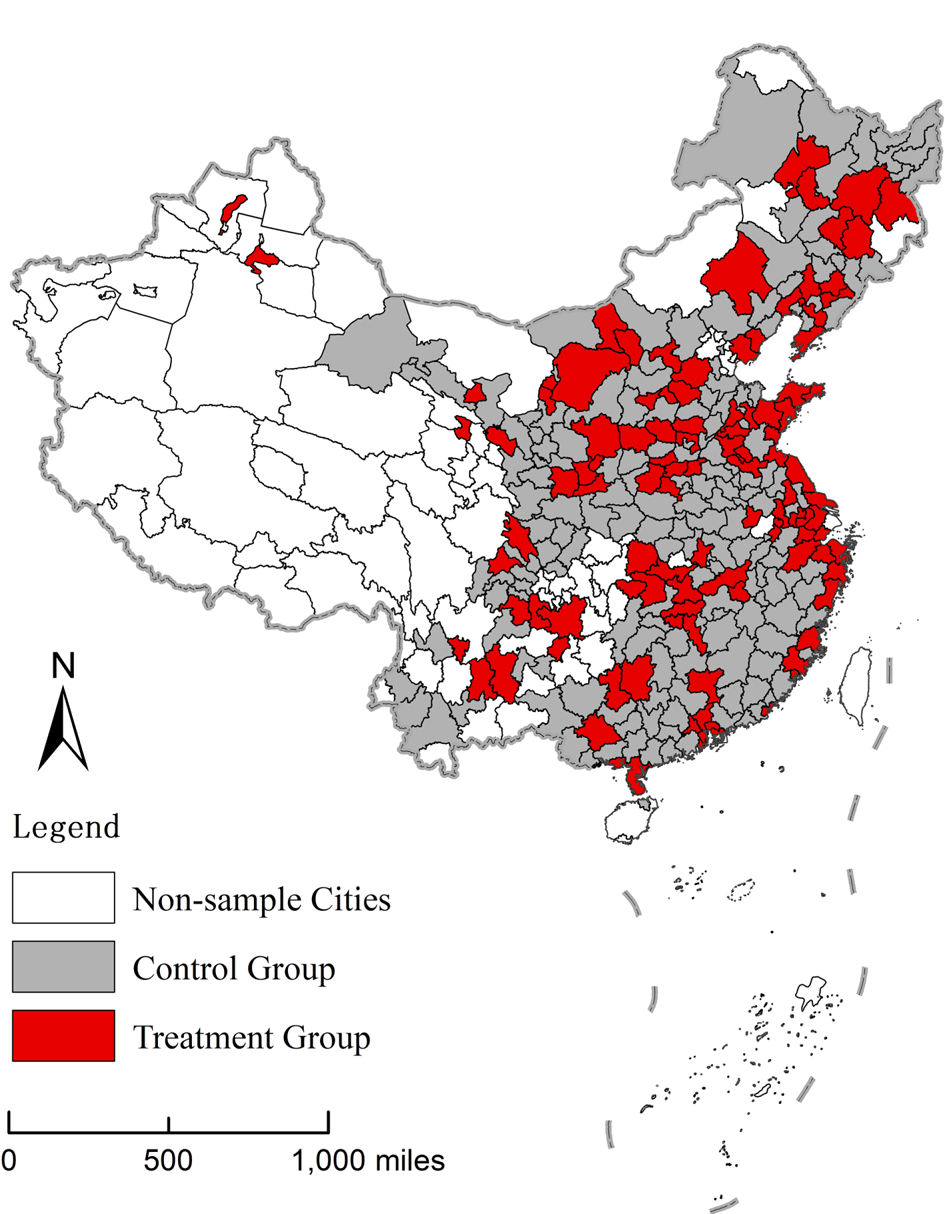
Figure 1. Distribution of pilot cities for environmental information publicity.
As specific measures to improve environmental information publicity, the document pointed out the following. First, in terms of government environmental information publicity, local environmental protection departments should, within their authority, not only disclose environmental protection laws and regulations and other normative policies to the public, but also actively disclose the local environmental quality status, environmental statistics and investigation information, the total amount and implementation of the policies for major pollutants, charging items, basis and standards of environmental protection, environmental protection administrative punishments, and other mandatory measures. Second, in terms of local environmental information publicity, enterprises should compulsorily disclose their total annual resource consumption, total environmental investment and technology development, waste disposal in the production process, social responsibility fulfillment, construction and operation of environmental protection facilities, and other information. At the same time, specific enterprises should also disclose the names, emission methods, and the concentration and total excessive amounts of major pollutants.
Additionally, the document detailed the steps, procedures, and supervision methods for environmental information publicity. The introduction of the policy marks the development of China's environmental regulation policies and the preliminary new stage establishment of the environmental information publicity system. The implementation of environmental information disclosure policy provides an important reference for local governments to master the current real situation of environmental pollution and formulate environmental governance policies. At the same time, it is helpful for the public to deeply understand the pollution level of the city and the pollution emissions of key enterprises, and supervise the pollution behavior of enterprises.
Since 2008, when the environmental information publicity policy officially came into effect, the Institute of Public and Environmental Affairs of China (IPE) and the Natural Resources Defense Council of the United States (NRDC) have jointly released the PITI, along with information on environmental publicity and enterprises' pollution for 113 environmentally-friendly cities on an annual basis.Footnote 2 The index marks and scores the implementation of the environmental information publicity system in the target cities according to eight criteria:
(1) disclosure of pollution sources' daily exceeding standards, violation records,
(2) disclosure of pollution sources' centralized rectification information,
(3) disclosure of cleaner production audit information,
(4) disclosure of enterprise environmental behavior overall evaluation information,
(5) disclosure of public information on environmental problems or enterprises' complaint letters, complaints and treatment results after investigation and verification,
(6) acceptance of environmental impact assessment documents of construction projects and disclosure of environmental protection acceptance results of construction projects,
(7) disclosure of pollution charges related information and
(8) disclosure of application.
This measure follows the current world trend of government environmental regulation and information disclosure. Taking the United States as an example, in 1986, the construction of the disclosure system for emission information on hundreds of pollutants by the government reduced the emission of chemical pollutants by 45.5 per cent in 10 years.Footnote 3 The establishment of an environmental information publicity system fully reflects the public's right to know and participate in environmental pollution and the government's actions on environmental protection. This approach is conducive to the scientific formulation and normative implementation of government environmental policies, as well as the enhancement of the government and the public's regulatory interaction on environmental pollution and protection, which is of significance to environmental legislation, pollution reduction, and sustainable economic growth.
As an initiative to strengthen environmental regulation and reduce environmental pollution, the establishment of an environmental information publicity system supports reducing total pollution emissions and limiting extensive production activities, thus playing an important role in environmental regulation (Li et al., Reference Li, He, Shao and Cao2018). This study found that: first, public supervision is conducive to the disclosure of environmental violations of enterprises,Footnote 4 which significantly increases the number of enterprises with environmental violations in the pilot cities. Second, the impact of public supervision on the disclosure of corporate environmental violations is significantly heterogeneous in urban environmental standards and the relationship between government and enterprises. Third, public supervision has achieved the expected environmental benefits, mainly realized by reducing enterprises' output to reduce polluting emissions, and this mechanism is more obvious for high-polluting enterprises.
3. Study design and data
3.1 Study design
This study takes the disclosure policy of PITI in 113 cities in China jointly published by the IPE and the NRDC as a quasi-natural experiment, and uses DID methods to identify the causal effect between public supervision and disclosure of enterprises' environmental violations. That is to say, in this paper, the cities that implement the disclosure policy of PITI were set as the treatment group, whereas the cities that do not implement the pilot served as the control group. The specific DID model is:

where Corporate violationit represents the level of enterprises' environmental violation of city i in the t year, measured by regional total number of enterprises with environmental violations and percentage of total number of enterprises with environmental violations in total regional enterprises, respectively. PITIi indicates whether city i implements the disclosure policy of PITI. If yes, the value is 1, otherwise, it is 0. The variable Timet indicates whether the time is after 2008 or not, and if it is after 2008, the value is 1; otherwise, it is 0. δt is the time fixed effects, μi is the individual fixed effects in the city, εi is the error term, and Controlit is the selected series of control variable. The coefficient β is the focus of research. If β > 0, it means that public supervision policy implementation is conducive to enterprises' environmental violation disclosure.
However, due to obvious differences between cities' environmental standards, and government-enterprise relations, these factors may affect the role of public supervision in disclosing enterprises' environmental violations, resulting in heterogeneity of results. In order to carry out the necessary empirical test on this analysis conclusion, we establish the following model:

where leveli indicates the difference in the environmental standards, and government-enterprise relations of city i. In the subsequent empirical tests, we distinguish the two with different standards to examine the heterogeneity of the role of public supervision in revealing enterprises' environmental violation in terms of environmental standards and government-enterprise relations, respectively. The coefficient γ is used to evaluate the heterogeneity effect of public supervision in disclosing enterprises' environmental violation under different factors.
Furthermore, the parallel trend assumption must be met. It assumes that the number of enterprises' environmental violations between the treatment group and the control group will not change significantly over time without the implementation of environmental information publicity. If there is a significant difference, the parallel trend hypothesis will not be met, and the regression results will be biased. Based on the above reasons, this paper expands on the basis of model (1) and establishes a dynamic effect model, as follows:

Parameter ${\theta _\tau }$![]() represents a set of evaluation effects, which indicates the role of public supervision of city i in disclosing environmental pollution violations in year τ, yearτ represents the dummy variable for each year, so as to examine dynamic effects of public supervision on enterprises' environmental violation disclosure. If the coefficients ${\theta _{2004}},\; \; {\theta _{2005}},\; \; {\theta _{2006}}\; \textrm{and}\; {\theta _{2007}}$
represents a set of evaluation effects, which indicates the role of public supervision of city i in disclosing environmental pollution violations in year τ, yearτ represents the dummy variable for each year, so as to examine dynamic effects of public supervision on enterprises' environmental violation disclosure. If the coefficients ${\theta _{2004}},\; \; {\theta _{2005}},\; \; {\theta _{2006}}\; \textrm{and}\; {\theta _{2007}}$![]() are not significant, it means that there is no systematic difference between the treatment group and the control group before policy implementation; otherwise, it means that there is a systematic difference, that is, the parallel trend assumption required by the DID is not met.
are not significant, it means that there is no systematic difference between the treatment group and the control group before policy implementation; otherwise, it means that there is a systematic difference, that is, the parallel trend assumption required by the DID is not met.
3.2 Variables
3.2.1 Dependent variable
This study evaluates the role of public supervision in the disclosure of enterprises' environmental pollution violations. Therefore, the dependent variable is the number of enterprises with environmental violation behaviors, measured as the regional total number of enterprises with environmental violations and the percentage of enterprises with environmental violations in the number of regional industrial enterprises in a city, respectively. To examine the environmental benefits of public supervision, the emission of industrial waste water, industrial waste gas, industrial smoke, and industrial sulfur dioxide were selected to measure the degree of environmental pollution in a region. Furthermore, in discussing the internal mechanism of environmental benefit generation, industrial sales output value, main business income, operating profit, and total profit of enterprises were selected to measure the change in enterprises' output scale.
3.2.2 Independent variable
Considering the disclosure policy of PITI as representative of public supervision, based on the PITI of 113 cities, this study exploits a quasi-natural experiment to make causal inferences. If a city published environmental information in 2008, it is considered that the city implemented a public supervision system, and the value of this independent variable is 1, and 0 otherwise.
3.2.3 Control variables
At the macro regional level, enterprises' environmental violations are not only driven by factors such as economic development, but are also restrained by regional marketization, public education level, and openness to the outside world. On the one hand, local governments sacrifice the environment and allow enterprises to engage in environmental pollution to actively develop the economy. On the other hand, the pressure of the public opinion and the improvement of environmental awareness may force the government to curb enterprises' environmental violations. Considering the above two factors, the GDP per capita, urbanization level, financial pressure and tax burden intensity are selected as control variables to measure the level of economic development, while the degree of openness to the outside world,Footnote 5 education level, market structure, and financial development are used to measure the degree to which an area attaches importance to environmental quality.
At the micro enterprise level, existing studies have shown that factors such as asset-liability ratio, scale, and owner's equity influence enterprise output, which is why the total assets are used in this study to measure an enterprise's scale, the logarithm of total enterprise debt to measure debt, the logarithm of total industrial sales value to measure output, time of enterprise establishment to measure age, and the ratio of the owner's equity to total industrial output value to measure the owner's equity of the enterprise. Additionally, the logarithm of administrative expenses is used to represent an enterprise's cost, the logarithm of the enterprise's payable income tax to illustrate the enterprise's tax burden, and the percentage of export delivery value to the total enterprise's industrial output value to illustrate the enterprise's export capacity. At the same time, the impact of the subsidy income on the enterprise's output is also taken into account. The variable selection is detailed in table 1.
Table 1. A description of specific variables and the descriptive statistics

Notes: The Environmental Violation indicators of enterprises at the urban level are selected from 2004 to 2012, the economic indicators at the urban level are selected from 2004 to 2012, which are derived from the China Urban Statistical Yearbook. The indicators at the enterprise level are selected from 1998 to 2011, which are derived from the China industrial enterprise database.
3.3 Data
Taking the disclosure policy of PITI as a quasi-natural experiment, this study investigates the effect of public supervision on enterprises' environmental violation disclosure. To address the fact that the literature has only focused on analyzing the environmental benefits at the macro level, we combine data at the regional level with data on enterprises at the micro level to detail the path of achieving environmental benefits through public supervision. The specific data are as follows.
First, this study starts at the macro regional level, taking 286 prefecture-level cities in China as the research object and using urban panel data from 2004 to 2012. The original data are from the statistical yearbooks of Chinese cities. The investigation period was selected from 2004 to 2012 because the data of enterprises' environmental violations can only be obtained from 2004 to 2012, which limits the sample period. In particular, the data on environmental violations mainly come from public enterprise environment reports published by the Research Center for Public and Environmental Affairs, a non-profit environmental organization, which released information on those enterprises whose water pollution exceeds the standard level. We manually collated the number of enterprises in each city that were disclosed as having excessive water pollution emissions between 2004 and 2012. The specific data descriptions are shown in figure 2.
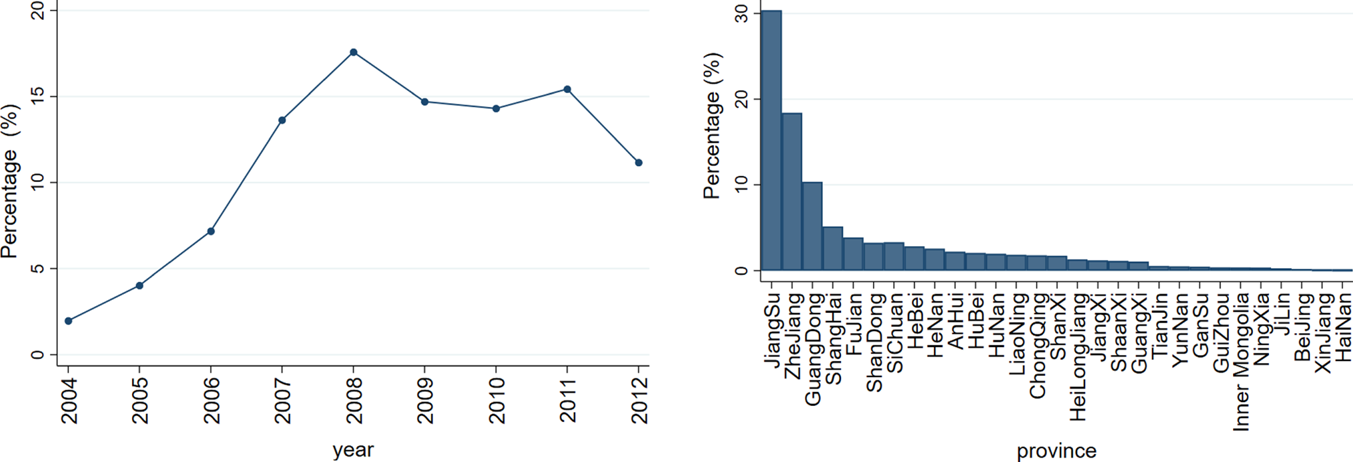
Figure 2. The time and regional distribution of enterprises with environmental violation behaviors.
Second, to investigate the impact of public supervision on enterprises' environmental violation disclosure, we used the disclosure policy of PITI to construct a quasi-natural experiment. Thus, the cities that implement the disclosure policy of PITI were set as the treatment group, whereas the cities that do not implement the pilot served as the control group.Footnote 6 Considering that the evaluation results are potentially affected by endogeneity, which can lead to biased estimation, we manually collected the number of public petitions on urban environmental issues from the China Environmental Statistics Yearbook.Footnote 7 And this number of public petitions was set as the instrumental variable. To eliminate the interference of other policies over the analysis period, we searched the websites of governmental agencies for the carbon pilot policy of ‘five provinces and eight cities, the “regional limited approval”, and “watershed limited approval” implemented by the State Environmental Protection Administration in some regions,Footnote 8 as well as the carbon trading pilot policy implemented in Beijing, Shanghai, Chongqing, Tianjin, Shenzhen, Guangdong, and Hubei’.
4. Empirical results
4.1 The impact of public supervision on enterprises' environmental violation disclosures
First, model (1) is regressed to investigate the effect of public supervision on enterprises' environmental violation disclosures. The results are shown in table 2. Column (1) shows the effects of public supervision on the regional total number of enterprises that disclose environmental violations, while column (3) shows the effects of public supervision on the relative number of enterprises that disclose environmental violation. Regardless of whether enterprises' environmental violation disclosures are measured by their total or relative numbers, public supervision promotes environmental violation disclosure, and this promotion effect is significant at the 5 per cent confidence level. Specifically, if other factors remain unchanged, the regression coefficients in columns (1) and (3) in table 2 show that, compared with regions without a public supervision system, a public supervision policy increases the regional total number of enterprises' environmental violation disclosure by 33.86 per cent and the relative number by 5.12 per cent.
Table 2. The impact of public supervision on enterprises' environmental violation disclosure
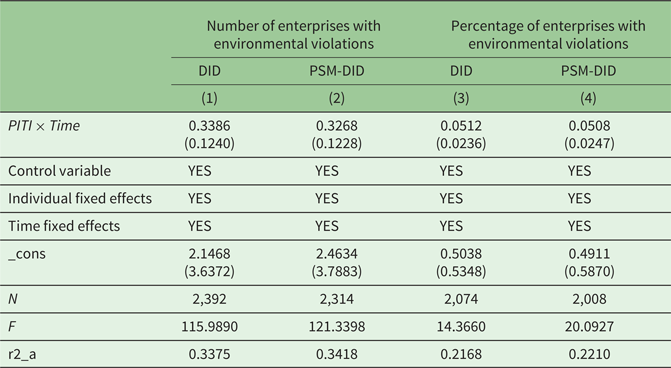
Note: The values in brackets are robust standard errors of clustering at the prefecture level.
Columns (1) and (3) in table 2 show the results for all cities. Considering that cities disclosing information publicity are distributed throughout the eastern, middle, and western regions, factors such as city size may cause large differences between the cities in the treatment and control groups, which may cause biased evaluation results and violate the parallel trend assumption. Therefore, to reduce this evaluation bias, we also use propensity score matching for calibration. The specific matching ideas are as follows. First, taking whether city publicizes environmental information as the dependent variable and using the economic growth rate, labor endowment, government size, and other factors as independent variables, the probit model is used to calculate propensity scores. The probit model is as follows:
$Pr\,\textrm{(Contro}{\textrm{l}_i}\textrm{)}$![]() represents the prediction probability that the city is selected to implement the environmental information disclosure policy.
represents the prediction probability that the city is selected to implement the environmental information disclosure policy.
Second, according to the calculated propensity scores, the nearest neighbor matching method is used to find cities in the control group that are similar to the sample cities in the treatment group. The specific match is as follows:
After matching, the cities that failed to be matched are eliminated and we conduct a DID analysis on the successfully matched sample. The specific results are shown in columns (2) and (4) of table 2. The public supervision system still promotes enterprises' environmental violation disclosure significantly.
4.2 Heterogeneity analysis of impact of public supervision on enterprises' environmental violation disclosure
From table 2, the public supervision system is conducive to revealing enterprises' environmental violations; however, considering the differences in environmental awareness and the government–enterprise relationship between cities, which may affect the role of public supervision, we regress model (2) to study the influence of the above factors, as shown in tables 3 and 4.
Table 3. Impact of public supervision on enterprises' environmental violations under different environmental standards
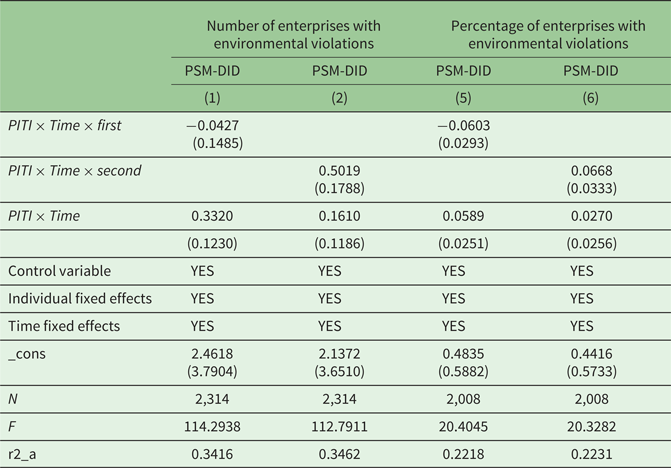
Note: The values in brackets are robust standard errors of clustering at the prefecture level.
Table 4. Impact of public supervision on enterprises' environmental violations under government-enterprise collusion
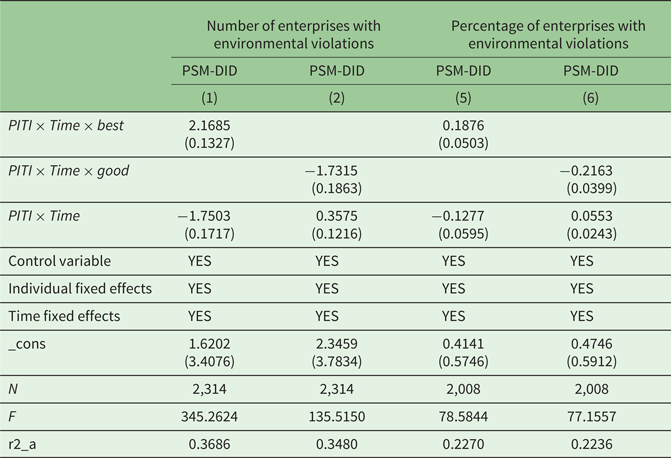
Note: The values in brackets are robust standard errors of clustering at the prefecture level.
First, the implementation effect of the public supervision system depends not only on regional legal systems construction, but also on urban environmental standards. That is, in cities with more stringent environmental standards, enterprises may have fewer environmental violations; conversely, looser environmental standards will lead to more obvious environmental violations. In short, these differences likely lead to different effects of public supervision. To test this assumption, this study divides all sample cities into first- and second-class cities according to the city level. Based on China's urban economic development stage and environmental governance, the environmental standards of first-class cities are higher than those of second-class production and so is the degree of environmental standards implementation. The results are shown in table 3. Columns (1)–(2) show the effect of public supervision on the regional total number of enterprises with environmental pollution violations disclosures in the different regions, and columns (3)–(4) investigate the effects of public supervision on the relative number of enterprises with environmental violation disclosure in different regions. Regardless of whether the total number or relative number of enterprises is used to measure environmental violation disclosure, the public supervision in regions with lower environmental standards is conducive to enterprises' environmental pollution violations disclosures, the effect being greater than in regions with higher environmental standards.
Second, the public supervision system is mainly advocated and implemented by the government, while environmental pollution violations are decided by the enterprises. Under the premise of changes in their external environment, enterprises may seek political assistance in the face of pressure due to public supervision. Enterprises form coalitions with local officials through bribery and other means to pursue benefits, while government officials may relax regulations and collude with enterprises for economic benefits. Therefore, government–enterprise collusion may weaken the role of public supervision in revealing enterprises' environmental pollution behaviors. To further test the impact of government–enterprise relationships, we classified the number of environmental pollution violations disclosed by enterprises in different cities and divided them into two categories: ‘best’ and ‘good’. The more enterprises violating environmental pollution regulations are disclosed, the lower the degree of collusion between government and enterprises in the city and the higher the incorruption of government officials. On the contrary, cities where the number of enterprises violating environmental pollution regulations are less disclosed may have a higher degree of collusion between government and enterprises, and incorruption of government officials is low. The results are shown in table 4.
The implementation of a public supervision system in regions with a higher government incorruptibility index has a stronger disclosure effect on enterprises' environmental violations than in regions with a lower government incorruptibility index. This shows that the effect of public supervision on enterprises' environmental violation disclosures increases with the strengthening of government–enterprise relationships. That is, the higher is the incorruptibility index, the lower is the probability of collusion between government and enterprises, the greater is the effect of public supervision in revealing enterprises' pollution behavior; moreover, the smaller is the incorruptibility index, the greater is the probability of collusion between government and enterprise and the lower is the effect of public supervision in revealing enterprises' pollution violations.
5. Further analysis
5.1 The mechanism of public supervision to expose enterprise environmental violations
The above analysis has shown that public supervision can significantly disclose enterprise environmental violations. Then, what is the internal mechanism of environmental information publicity to improve the public's disclosure of enterprise environmental violations? In order to explain this mechanism, this paper analyzes the contents of China's implementation of environmental information publicity policy, and believes that the internal mechanism of public supervision to expose enterprise environmental violations focuses on the following two aspects.
From a personal perspective, environmental information publicity can make residents more truly understand the current situation of environmental pollution in the city where they live. Serious environmental pollution will make residents aware that their health will be threatened. Therefore, in order to protect their own health, residents will actively supervise the environmental pollution emissions of enterprises, especially the pollution emissions of key enterprises in the city with environmental information publicity. Once the enterprise is found to have environmental pollution violations, the residents will complain to the government department, and finally the enterprise with environmental pollution violations will be publicized in the society.
From a social perspective, during the implementation of the environmental information publicity policy, the objective is not only to disclose the environmental pollution information of the pilot cities, but also to publicize the concept of public participation in environmental governance to actively promote and popularize public participation in urban environmental pollution governance. On the basis of this publicity and promotion, the public will directly participate in urban environmental governance through the supervision of environmental violations of enterprises, timely report environmental pollution violations of enterprises, and reduce urban environmental pollution emissions.
Therefore, whether for personal interests or social welfare, the public will disclose environmental pollution violations of enterprises through supervision, reduce urban environmental pollution emissions and improve environmental quality.
5.2 Unexpected effects of public supervision
The above empirical tests fully demonstrate that public supervision policies can effectively reveal environmental violations. With the gradual implementation of these policies, environmental quality should be greatly improved, which is also the ultimate goal of environmental governance. This section analyzes whether public supervision can help improve regional environmental quality and the internal mechanisms, thus providing important implications for effective public supervision policies.
First, we test the improvement of environmental quality by public supervision to answer the first research question. To measure environmental quality, we refer to the literature. Namely, we select urban industrial waste water discharge (water), industrial smoke emissions (fog), industrial dust emissions (dust), and industrial sulfur dioxide emissions (so2) to measure regional environmental pollution status, and use the DID method to assess the impact of public supervision on environmental quality. The results are shown in table 5. Regardless of which indicators are used to measure regional environmental pollution, the public supervision system has a significant negative effect on environmental pollution emissions. That is, public supervision policies effectively improve environmental quality in a jurisdiction and achieve the expected environment quality.Footnote 9 The explanation for this result is that public supervision makes a large number of environmental pollution violation enterprises be disclosed, while in China, the direct result of disclosure is the shutdown and rectification of enterprises, which ultimately reduces the pollution emissions of cities.
Table 5. Impact of public supervision on urban environmental pollution emissions
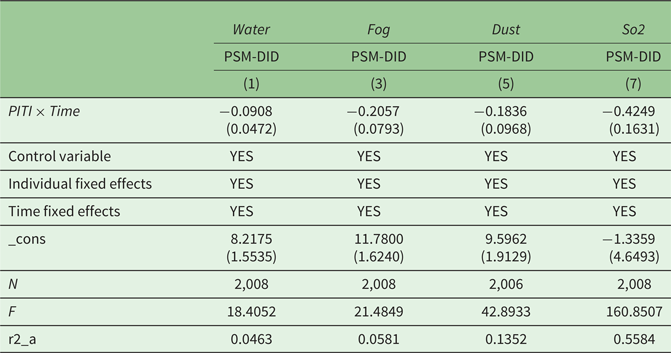
Note: The values in brackets are robust standard errors of clustering at the prefecture level.
The results in table 5 show that public supervision effectively reduces the different types of pollution emissions and improves regional environmental quality. However, for the internal mechanism for environmental quality improvement, we focus on the path of the public supervision system to achieve environmental benefits. The public supervision system can effectively reveal enterprises' environmental violations, rectifying and reforming these enterprises, which is mainly reflected in an enterprise's output and benefits. To test this, we select the enterprise's output scale (productscale), total income (income), operating income (revenue), and operating profit (profit) to measure the enterprise's output and income, and the results are shown in table 6. Compared with the regions without public supervision policies, enterprises' output and income in policy implementation regions decline significantly.
Table 6. Impact of public supervision on enterprise's output

Notes: (1) The values in brackets are robust standard errors of clustering at the prefecture level; (2) Control variables include size, debt, right, firmtax, age, cost, export, subsidy.
Although table 6 shows the mechanism of public supervision to achieve environmental benefits, considering differences in the pollution discharge of different types of enterprises, we believe that the impact of public supervision on enterprises' output and income can differ. To further test the above mechanism, we divide enterprises according to the degree of environmental pollution into strongly and weakly polluting enterprises, and examine the impact of public supervision on the output and income of these enterprise types. The results are shown in table 7. Columns (1)–(4) examine the impact of public supervision on the output and income of strongly polluting enterprises, while columns (5)–(8) analyze the impact of public supervision on the output and income of weakly polluting enterprises. From the regression results, regardless of whether an enterprise is strongly or weakly polluting, public supervision has a significant inhibiting effect on enterprise output. However, from the coefficients, the inhibiting effect of public supervision on the output of strongly polluting enterprises is higher than for weakly polluting enterprises. This indicates that the reason for environmental quality improvement lies in enterprises' environmental violations disclosures, which can reduce both output and emissions. In addition, this inhibiting effect is more obvious for strongly polluting enterprises.
Table 7. Impact of public supervision on different types enterprise's output

Notes: (1) The values in brackets are robust standard errors of clustering at the prefecture level; (2) Control variables include size, debt, right, firmtax, age, cost, export, subsidy.
6. Conclusions
The frequent occurrence of environmental violations is a common problem in developing countries, which is why disclosing and curbing such behaviors by enterprises is a joint worldwide effort. As the largest developing country, China has implemented the disclosure policy of PITI through the publication of environmental information to encourage the public to actively participate in environmental governance, thus curbing environmental pollution violations. In view of this, this study uses the disclosure policy of PITI in 2008 to construct a quasi-natural experiment, utilizes DID to evaluate the role of public supervision in disclosure of enterprises' environmental violations, and investigates its environmental benefits and realization path, thus providing solutions and ideas for other developing countries to solve environmental pollution problems.
The main conclusions are as follows. First, public supervision is conducive to the disclosure of enterprises' environmental violations and significantly increases the total and relative numbers of enterprises with environmental violations in the regions where environmental information is published. The results of the model evaluation show that the implementation of a public supervision policy increases the total number of enterprises that disclose environmental pollution violations by 33.86 per cent and the relative percentage by 5.12 per cent. Second, the disclosure effect of public supervision on enterprises' environmental violation behavior has significant heterogeneity according to the environmental standards and government-enterprise relations. In regions with low environmental standards, public supervision can play a more significant role in disclosing enterprises' environmental violations. At the same time, the collusion between the government and enterprises will weaken the effect of public supervision to curb enterprises' environmental violations. Third, public supervision reduces the emission of various environmental pollutants in regions where environmental information is published and achieves the expected environmental benefits. The main way to realize environmental benefits is thus to reduce pollution emissions by reducing enterprise output, and this mechanism is more obvious for high-polluting enterprises.
The above conclusions lead to the following policy suggestions. First, in the process of environmental governance, we should not only reduce the emission of environmental pollution through the actions of the government and enterprises, but also stimulate the public to effectively supervise enterprises' environmental violation behaviors, and further enhance the roles of the government, enterprises, and the public in improving the environmental quality. Second, we must consider the process of environmental governance comprehensively. That is to say, it is necessary to take into account not only the intensity and implementation effect of environmental regulations, but also the differences in the legal system, environmental standards and government-enterprise relations among different regions, thus ensuring the expected effect of environmental policies.
Supplementary material
The supplementary material for this article can be found at https://doi.org/10.1017/S1355770X22000304.
Acknowledgements
This research is funded by the Youth Project of National Natural Science Foundation of China (No.72103163), Natural Science Basic Research Program of Shaanxi (No. 2021JQ-457), China-Central Eastern European Countries Higher Joint Education Project (No. 202028). General project of Shaanxi Province Philosophy and Social Science Major Theoretical and Practical Issues Research (No. 2022ND0325), Young Talents Supporting Program Project of Xi'an Association for Science and Technology (No. 0959202 21369). This research is also supported by Shaanxi Key Laboratory of Carbon Neutralization.
Conflict of interest
None.


